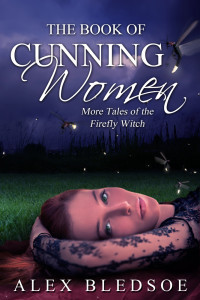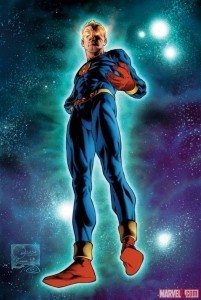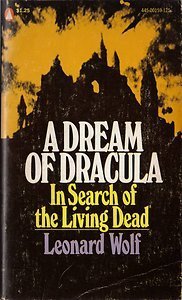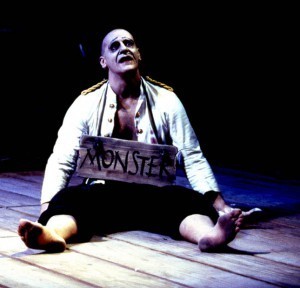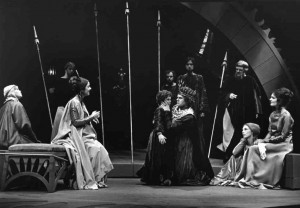Alex Bledsoe's Blog, page 17
October 21, 2013
Just in time for Halloween: new Firefly Witch stories!
Three new stories featuring Tanna Tully, a.k.a. Lady Firefly, have arrived just in time for the quintessential witches’ holiday, Halloween (or Samhain, if you want to be technical about it). Here’s a bit about The Book of Cunning Women.
In “The Mischief Shades,” she investigates a seemingly light-hearted haunting borne of a ghastly tragedy that hits surprisingly close to home; in “Tourist Trap,” a friend’s suicide attempt exposes something long buried in a local park; and in “The Book of Cunning Women,” an artifact that could change history has to be pried from the selfish grasp of a popular novelist in the heart of Southern Gothic country, New Orleans.
This collection is available on Kindle, and will soon be on Nook, Kobe and all the other usual platforms.
And if you like it, please leave an honest review at the site of your choice.
October 14, 2013
The Return of Miracleman!
I haven’t been a serious comic fan in a long time. It’s nothing against the form–graphic, visual storytelling is as valid as the novel, the short story or the TV series–but my own life changed in such a way that the tales being told in the medium stopped speaking to me somewhere in the 1990s.
But when I read that Miracleman was coming back, I felt a stirring of that old enthusiasm. Because Miracleman (or Marvelman as he was known in his native UK) was the best comic series I ever read.
Brief history: In the 1980s, writer Alan Moore (Watchmen, Swamp Thing, V for Vendetta) resurrected the British version of Captain Marvel, a light kids’ hero comic, as a dark commentary on the Britain of his day. He also, because he’s brilliant, used it as a way to show what the then-real world would become if a character as omnipotent as Superman really did appear in our midst. He didn’t shy from depicting the horrible things men, and supermen, could do to each other, and to the rest of us. But through it all were rays of hope, and love, and a belief in the future.
One of the things that made Miracleman so noteworthy was that the company producing it, Eclipse, couldn’t seem to make it appear on a regular schedule. The gap between the cliffhanger at the end of issue 6 and its resolution in issue 7 was months. And this was all prior to the internet, so there was no reliable source of information for fans like me, attending college in Tennessee and dependent on the whims of the local shop owner (a teenage whiz kind indulged by his parents with a comic shop nestled inside their antiques store). We could only show up every week and hope for the best.
But it was all worthwhile for the story Moore was telling.
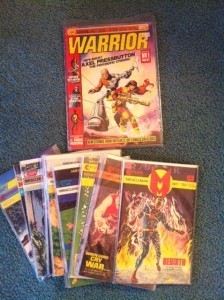
Okay, I’m showing off a little: here’s my collection of Miracleman 1-16, along with the first issue of the UK comic Warrior, which ran the first episode of Miracleman.
When you mention Miracleman today, you often get blank looks: fans know the name, but few people younger than me have ever read it. The series, including the graphic novel issue collections, have been out of print for probably twenty years, due to a rights tangle than has only now been resolved (thanks to Neil Gaiman’s artistic and socio-economic muscle). Gaiman took over for Moore as the series writer, and had the thankless task of continuing a story that had effectively ended, much like Twin Peaks after they solved the murder of Laura Palmer. And as part of the new run, Gaiman will “conclude” the series, with new issues once the old ones have been reprinted.
Of course, all that is marketing, and that’s fine. You have to attract attention. But the true story of Miracleman finished with Alan Moore’s issue #16, and to have that story back in print after all this time is nothing but good news.
So if you don’t know what KIMOTA! means…soon, you will.
October 7, 2013
Get Your Name (And Favorite Song) in a Tufa Novel
Anita Covington recently lost her husband to cancer and within two weeks was also involved in a near fatal motorcycle accident. She has massive injuries (detailed on the website) and is still in the hospital. Like so many people, Anita has no insurance. She is 62 years old.
The band Tuatha Dea has organized an auction to raise money for her medical bills, and to provide modifications for her home necessary for her recovery.
I’ve donated a Tuckerization for the next Tufa novel, Long Black Curl, out in 2015. But it’s a special kind: not only can you get a character named after you (or the person of your choice), you also get to see your favorite folk song mentioned in the story.
You can bid on this, and many other great items, at the auction site here. You can also follow the the auction on Facebook.
So pay it forward, and get a little immortality in the process.
The First Drop of Blood: A Dream of Dracula
It’s now possible to find gazillions of non-fiction books on Dracula, novel or historical character or cultural figure. I recommend anything by Elizabeth Miller. But in the early 70s, there was really only one: A Dream of Dracula: In Search of the Living Dead, by Leonard Wolf.
It’s a long-form meditation on what vampires and Dracula mean to people in the (then) contemporary world. He talks to modern supposed vampires, visits Transylvania and sees an awful lot of movies. His insights are occasionally brilliant but often rather obvious; yet it has to be remembered, he was the first one writing this stuff for a popular audience. It’s like high school students who don’t like Hamlet because it’s full of cliche’s.
Wolf was actually born in Transylvania, and the book is a dive into both the legend of Dracula in popular culture, and into the psyche of Leonard Wolf. One is obviously more interesting now than the other, but even the personal asides and extended vignettes have their entertainment value. Wolf was writing at the end of the Sixties, so some of his interviewees actually use phrases like, “groovy” and “turned on.” He lets us into his sex life, which seems to involve younger women, including students (this was not considered so improper back in the full flush of the sexual revolution). He talks a lot about how his discoveries and insights make him feel. So it’s very much a book of its time.
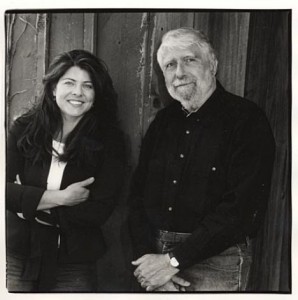
Leonard Wolf with his writer daughter, Naomi.
Still, it’s got some value, and Wolf can turn a phrase and make a pithy observation. He calls Vlad the Impaler “a practical joker of agony” (p. 244). Of the heroes of Stoker’s novel, he says, “They were strange, one may suppose, even before Dracula came into the lives of the men” (p. 210). And on contemplating his own mortality in the mirror, he writes, “The man I see in the mirror gets a look of surprised misery in his eyes, as if he heard the flapping of leather wings bearing creatures through the darkness who will converge on the fluorescent-lighted silver rectangle of the mirror where his face is illuminated, trapped” (p. 92). Whew.
Reading it today, and as a fan of the topic, I’m especially swept along in the enthusiasm Wolf has for his subject. He knows, despite the critical consensus at the time, that there’s something valuable here in the conjunction of history and pop art, in the transformation of Vlad Drakul into Count Dracula. He may never quite articulate it, but he gets most of the way there, and he gives later scholars a good spot to start.
September 23, 2013
Hearing Voices
A while back, Facebook friend Diana May-Waldman asked me, “When you write, do you ever get stuck in character for a little while?” My initial response was an instantaneous, “no,” but then I got to thinking about it.
I write two series in first person: my Eddie LaCrosse novels, and the Firefly Witch short stories. When you write in first person, you’re telling the story in a particular character’s voice, not your own. It may be similar–I’m not sure how you could avoid that, especially if you’re writing a series–but even if it’s identical to the way you speak to yourself in your head, to the reader is becomes the inner voice of your character, and you have to be aware of that.
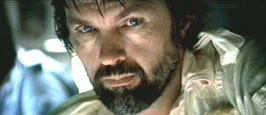
Tom Skerritt. the ideal image of Eddie LaCrosse
After five novels and a handful of short stories, it’s now incredibly easy for me to slip into Eddie LaCrosse’s voice. And it’s a fun voice: he’s cynical, which means he’s got a great sense of humor, and he’s seen everything, so it takes a lot to impress him. Part of the enjoyment of writing the series is thinking of new things just to see how he’ll react. And because he’s the viewpoint character, it also means that I never have to worry about how to present something: everything comes through his perceptions. If he doesn’t experience it, it must not be too important to the story.

Nancy Travis, my original idea of Tanna Tully.
Ry Tully, my other first-person character, is different in a lot of crucial ways. First, he’s not the main character of his stories: his wife Tanna is. In the same way Watson chronicles Sherlock Holmes, Ry gives us Tanna’s adventures from an outsider’s perspective. He’s a down-to-earth small-town newspaper editor, while she’s witch, a psychic and a college professor. And the reasons for this are probably the same ones that led Conan Doyle to his approach: Tanna often knows things that would kill the suspense if we were inside her head. Far more importantly, Ry represents the reader in a way Tanna never could. He’s amazed, astounded, and terrified by what they encounter, while Tanna seldom is; and when she is, it amazes/astounds/terrifies Ry even more.
(Another interesting thing about Ry: I have no “ideal” image of him in my head. I’ve always envisioned Alien-era Tom Skerritt as Eddie, and Nancy Travis as Tanna, but when I thought about who best visually represented Ry, I came up blank. Perhaps it’s because I originally wrote about Eddie in third-person, and saw him objectively, before deciding to shift to his perspective, whereas Ry has always been written in first person, so I’ve always looked out from his eyes.)
I’ve been writing about Ry Tully almost as long as I have Eddie LaCrosse, and both reflect the hard-boiled influences of Hammett, Chandler and Parker, all of whom wrote stories with cynical, tough, first-person narrators. And there are undeniable similarities between these two characters. But in my head, they’re never the same, and only occasionally do I find myself saying, “Whoops, that’s something Ry would say, not Eddie,” or vice versa.
So I’ll have to modify my original answer to, “Rarely.” But thanks, Diana, for making me think about it in ways I never have. It’s always good to pick apart your inner process and make sure you’re not sabotaging yourself.
September 18, 2013
Another ARC of He Drank, and Saw the Spider
So it’s time for another visual clue to some of the things you’ll find in He Drank, and Saw the Spider, the upcoming fifth Eddie LaCrosse novel. Since I gave away two ARCs last time (due to a tie), for this caption contest I’ll give away two more. Leave your comment by midnight Sunday, September 22 for a chance to win.
September 16, 2013
Guest blog: Steve McHugh on Changing Times
My friend novelist Melissa Olson put me on the track of Steve McHugh. He’s the author of the Hellequin Chronicles series, about an immortal sorcerer who still battles evil in the modern day. I asked him to talk a bit about how he chooses the flashback scenes for the novels, which jump back and forth through time, much like the film and TV series he mentions as an influence.–A.B.
***
Back in 1986 there was a film called Highlander. For those of you who haven’t seen it, just take my word for the awesomeness that was contained within that 90 mins. Apart from having Queen do the soundtrack and having a Frenchman play a Scotsman and a Scotsman play a Spaniard, the thing that stuck with me the most were the flashbacks. The main character, Connor Macleod (of the Clan Macleod) was a 500 year old Scottish warrior and the story followed his battle against an evil nemesis in 1980s New York. But throughout the story there were flashbacks to previous parts of his life, from the Highlands of Scotland to Nazi Germany.
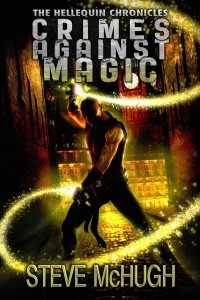 I found it incredibly interesting that we got to see parts of his life throughout the ages. And then when the Highlander TV show started in ’92 (with Duncan Macleod) they kept the idea of each episode having flashbacks to the main characters 500+ life. So, when it came to write my own books, I knew I was going to use the idea. The main character, Nathan Garrett, is a 1600-year-old sorcerer, so that gave me a huge scope to add the flashback portions of his life into the book. I wanted the flashbacks to have a relevance to the storyline of the current time, be that introducing characters or situations that were still in the modern portion of the book. The hard part was figuring out what setting to use. Less than a quarter of the book would be set in the flashback sequences, but they still had to make sense and tie in with the modern story.
I found it incredibly interesting that we got to see parts of his life throughout the ages. And then when the Highlander TV show started in ’92 (with Duncan Macleod) they kept the idea of each episode having flashbacks to the main characters 500+ life. So, when it came to write my own books, I knew I was going to use the idea. The main character, Nathan Garrett, is a 1600-year-old sorcerer, so that gave me a huge scope to add the flashback portions of his life into the book. I wanted the flashbacks to have a relevance to the storyline of the current time, be that introducing characters or situations that were still in the modern portion of the book. The hard part was figuring out what setting to use. Less than a quarter of the book would be set in the flashback sequences, but they still had to make sense and tie in with the modern story.
For Crimes Against Magic (the first book in the Hellequin Chronicles) it took me a while to work out the exact date that I wanted to use. I had the idea of setting it during the hundred years war in the 15th it down to the battle of Agincourt in 1415, but I didn’t want to use the battle itself as some would have noticed if there was a sorcerer flinging fire about the place. So after some research (and reading the wonderful Agincourt by Bernard Cornwell, I settled on the 1414 destruction of the city of Soissons. From there the flashback came pretty easily, as did having it sync up with the current story.
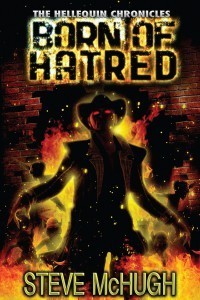 My second book, Born of Hatred, was a little easier. I wanted to write it in the late 19th century in America. From there I just researched the country, getting closer and closer to the state that worked and eventually settling on Montana. At the time, Montana wasn’t part of the United States, so that gave me a few plot ideas and the managed to set the whole flashback in stone.
My second book, Born of Hatred, was a little easier. I wanted to write it in the late 19th century in America. From there I just researched the country, getting closer and closer to the state that worked and eventually settling on Montana. At the time, Montana wasn’t part of the United States, so that gave me a few plot ideas and the managed to set the whole flashback in stone.
Book 3, With Silent Screams, isn’t out until next February, but it was the book that has given me the most trouble with the flashbacks. I originally had it down as being 1970s Wisconsin and even wrote it in that way, but over time it changed to 1970s Maine for various story reasons that just made sense.
I have several more books plotted out in the same series, and have already got ideas for the flashback parts for each one. Sometimes I think I’m just making my life harder for myself, but then I realize that I really do love writing the flashback parts and all the research that goes into making them engaging. Besides when you have a 1600 year old character to write, you might as well make use of his huge life to do things you could never do with a human character.
***
Thanks to Steve McHugh for sharing his process. You can find him at his website, on Facebook and on Twitter.
September 9, 2013
Don’t Get Rock Blocked
“On some nights I still believe that a car with the gas needle on empty can run about fifty more miles if you have the right music very loud on the radio.” –Hunter S. Thompson
When I was a teenager–and I suspect this is true for most people reading this–music was incredibly important to me. I didn’t play an instrument, but I had strong opinions and preferences, and I would listen to records (yep, I’m that old) with the kind of attentiveness that would probably be diagnosed as ADD today. I absorbed the trivia found in Rolling Stone magazine, kept up with the charts and eagerly awaited the next release by the artists I followed.
I also insisted upon the sanctity of the music experience. By that I mean that if I was listening to something, whether it was the Bee Gees or Lynyrd Skynyrd, I would get irate–sometimes vehemently so–when interrupted. My parents (neither of whom I recall as having a favorite song, unless it was a hymn) never understood that. But music was crucial to me; it certainly gave me hope and meaning when nothing else did.
Now, the Bible says, “When I was a child, I spoke like a child, I thought like a child, I reasoned like a child. When I became a man, I gave up childish ways.” Or, more appropriately, in “Two Hearts,” Bruce Springsteen says:
Once I spent my time playing tough guy scenes
But I was living in a world of childish dreams
Someday these childish dreams must end
To become a man and grow up to dream again
So the question becomes: is making the act of listening a priority one of those “childish ways,” a “childish dream?”
I say, no. Hell, no.
I am on this soapbox (made of old record crates from Peaches Music and Video) to insist on the importance of listening to music. We live in a crass, obvious, entirely profit-driven world, and the only way that’s going to change is for people to pay attention, really pay attention, to things that aren’t crass, obvious and entirely profit-driven. Sure, there’s lots of crass, obvious, entirely profit-driven music out there; but there’s also good stuff, real stuff, that deserves our attention. Music can help us escape, but it can also be a way to confront the very real problems we encounter. The right song at the right moment can change the course of your life.
Someone coined the term “rock blocked” for when your listening is interrupted by something tedious and mundane, usually at the point where you’re in the middle of that air guitar solo or lip-synching to the most emotional part of the lyrics. It happens to everyone, and it certainly happens more when you’re an adult, because most other adults assume that, unless you’re in the music business, listening can’t be that important. But that’s wrong.
So stand up for your right to listen. Carve out that space for music, because you never know when it could be one of those songs, one of those moments that changes your life. Don’t let yourself get rock-blocked!
September 4, 2013
Second hint, and a chance to win an ARC
As I said last week, the advance reader copies (ARCs) of He Drank, and Saw the Spider are available, and they do me no good sitting in the box in my study. So below you’ll find another photographic hint about the book. And here’s the contest: the best caption (as determined by me) wins a signed ARC! So leave a caption in the comments below before midnight on September 8. (International entries are eligible, too.)
September 2, 2013
An Average Day in the Word Mines

This is what my desk looks like as I write this blog post.
A while back, I asked for blog topic suggestions, and my pal Bill Bodden actually gave me three that were related. So I’m answering this trio of writing-related questions as one blog post. Thanks, Bill!
How much time do you spend writing in an average day? Do you set word count goals, page goals, or do you not set goals for yourself when writing?
My goal is 1,000 new words a day. It’s a nice round number, and works out to about four manuscript pages in Courier New 12 point, the font I write in because I’m old enough to remember writing on typewriters. Time-wise, that can take anywhere from an hour to all freaking day, depending on (for lack of a better term) my “mojo.” If it’s a scene that involves a lot of dialogue, and has a clear narrative point, I can bang that right out. If it’s prose, especially background or transitional passages, it goes much more slowly. I tend to do my writing before lunch, either early before everyone else gets up (I have a wife and three kids, so I have to grab the peace and quiet when it comes) or during the day when everyone’s gone to work and/or school. After lunch, I tend to work mainly on editing, and by dinner time my brain is too fried to do anything but watch reruns of River Monsters.
How do you avoid the temptation to go back and correct things in a WIP before adding more text?
I don’t typically worry about that. My creative process tends to be linear, but if something is really pressing at me, I have no qualms about going back and working where it’s needed. I’ve written a lot at this point in my life, and I’m pretty good (though far from flawless) at knowing which ideas will keep and which ones won’t. The implied statement in your question is correct, though: I prefer to do drafts straight through, then revise once I have the whole thing in front of me.
Do you write from beginning to end, or write chapters as they come to you and link them together later?
I used to do the latter, very early in my writing life, but what I found was that the linking process never really worked for me. I ended up with clunky transitions and characters that didn’t really develop, but just stumbled from one scene to the next. I’m also not much of an outliner, unless there’s a specific reason (i.e., an editor wants one, or the plot is ridiculously complex). I prefer to work toward a general idea of the conclusion, while staying open to possibilities that may arise from the text. And to do that, I really have to pursue the story in its order, or it would be like creating puzzle pieces without knowing what the final picture’s going to look like.
Thanks again to Bill Bodden for the questions; you can find both Bill and I in the Alliteration Ink anthology Sidekicks!
And if you have any questions you’d like me to answer, leave them in the comments below.

